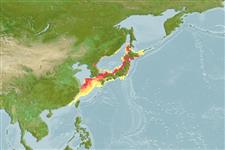Environment: milieu / climate zone / depth range / distribution range
Ecología
marino demersal; rango de profundidad 15 - 269 m (Ref. 58496). Boreal
Distribución
Países | Áreas FAO | Ecosistemas | Ocurrencias, apariciones | Point map | Introducciones | Faunafri
Northwest Pacific: Japan and the Sea of Okhotsk.
Tamaño / Peso / Age
Maturity: Lm ? range ? - ? cm
Max length : 44.0 cm TL macho / no sexado; (Ref. 56527); common length : 31.5 cm TL macho / no sexado; (Ref. 56557); peso máximo publicado: 1.0 kg (Ref. 56527)
Espinas dorsales (total): 9 - 10; Radios blandos dorsales (total): 14-17; Espinas anales 0; Radios blandos anales: 13 - 16
Life cycle and mating behavior
Madurez | Reproducción | Puesta | Huevos | Fecundidad | Larva
External fertilization with internal insemination (Ref. 101419). This is also called 'internal gametic association' which describes another unique phenomenon of the reproductive process. In this phenomenon, the presence of the spermatozoa in the ovarian cavity is done through copulation, but the spermatozoa entry into the egg and subsequent fertilization only occurred externally when the eggs are spawned and came into contact with seawater (Ref. 101419).
Nakabo, T., 2002. Fishes of Japan with pictorial keys to the species, English edition I. Tokai University Press, Japan, pp v-866. (Ref. 41299)
IUCN Red List Status (Ref. 130435)
Threat to humans
Harmless
Human uses
Más información
ReferenciasAcuiculturaPerfil de acuiculturaRazasGenéticaElectrophoresesheritabilidadEnfermedadesProcesamientoNutrientsMass conversion
ColaboradoresImágenesStamps, Coins Misc.SonidosCiguateraVelocidadTipo de nataciónSuperficie branquialOtolitosCerebrosVisión
Herramientas
Special reports
Download XML
Fuentes de Internet
Estimates based on models
Preferred temperature (Ref.
123201): 3.6 - 17.3, mean 12.9 °C (based on 37 cells).
Phylogenetic diversity index (Ref.
82804): PD
50 = 1.0000 [Uniqueness, from 0.5 = low to 2.0 = high].
Bayesian length-weight: a=0.00676 (0.00300 - 0.01523), b=3.17 (2.98 - 3.36), in cm total length, based on LWR estimates for this (Sub)family-body shape (Ref.
93245).
Nivel trófico (Ref.
69278): 3.6 ±0.4 se; based on diet studies.
Resiliencia (Ref.
120179): Muy bajo, población duplicada en un tiempo mínimo superior a 14 años (Preliminary K or Fecundity.).
Fishing Vulnerability (Ref.
59153): Low to moderate vulnerability (34 of 100).
